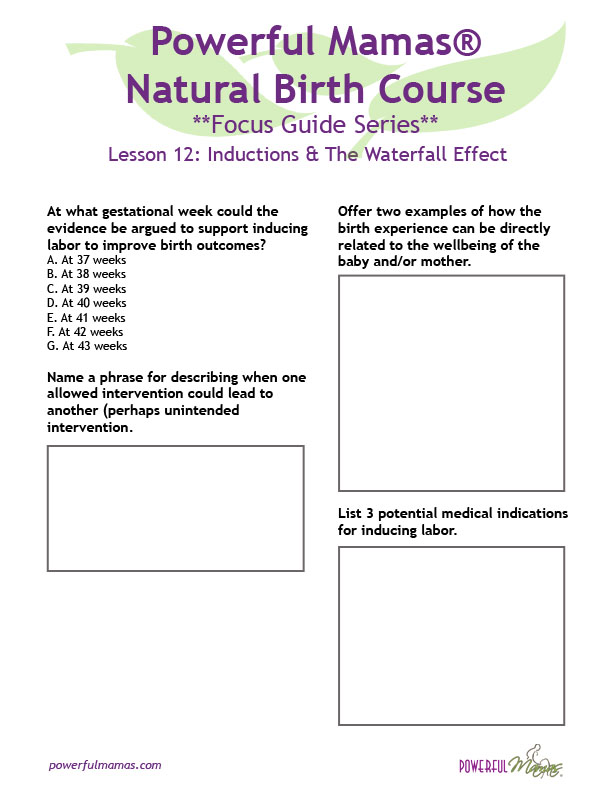Lesson 12: Inductions & The Waterfall Effect
"Just as a woman's heart knows how and when to pump, her lungs to inhale, and her hand to pull back from fire, so she knows when and how to give birth." ~ Virginia Di Orio
introduction

As Grandma Says, the Apple Will Fall When the Fruit Is Ripe!
Unbeknownst to many, inducing labor has significant risk factors. Inductions for non-medical reasons are one of the leading causes of c-sections in this country, especially in first-time mothers.
In this lesson we will play a game where you must weed out medical indications for an induction from likely non-medical reasons; such as trying to avoid birth on a particular holiday... Guess which category that one falls into?!? :) Some of the non-medical reasons for induction may seem obvious at first, but at times the answer is not so clear. Follow along and see how YOU would categorize each reason given for induction. Does it sound like a medical or a non-medical reason to interfere with baby's arrival??? Some of the non-medical reasons might be pretty tempting, but you must ask yourself if it is the safest/healthiest option for mom and baby. Each family must ultimately decide for themselves if the benefits outweigh the risks of moving forward with an induction or augmentation of labor.
In the second part of this class we discuss "The Waterfall Effect", which is a term used to describe what can happen when one early intervention leads to another, often unexpectedly. Inductions are just one way the Waterfall Effect can begin, but any intervention in the natural process of labor could potentially have unforeseen side effects, even an unplanned c-section. Listen closely and follow along with the visual aids to begin to connect how one procedure has the potential to snowball into another.
Unbeknownst to many, inducing labor has significant risk factors. Inductions for non-medical reasons are one of the leading causes of c-sections in this country, especially in first-time mothers.
In this lesson we will play a game where you must weed out medical indications for an induction from likely non-medical reasons; such as trying to avoid birth on a particular holiday... Guess which category that one falls into?!? :) Some of the non-medical reasons for induction may seem obvious at first, but at times the answer is not so clear. Follow along and see how YOU would categorize each reason given for induction. Does it sound like a medical or a non-medical reason to interfere with baby's arrival??? Some of the non-medical reasons might be pretty tempting, but you must ask yourself if it is the safest/healthiest option for mom and baby. Each family must ultimately decide for themselves if the benefits outweigh the risks of moving forward with an induction or augmentation of labor.
In the second part of this class we discuss "The Waterfall Effect", which is a term used to describe what can happen when one early intervention leads to another, often unexpectedly. Inductions are just one way the Waterfall Effect can begin, but any intervention in the natural process of labor could potentially have unforeseen side effects, even an unplanned c-section. Listen closely and follow along with the visual aids to begin to connect how one procedure has the potential to snowball into another.
learning goals & focus guide
 Right Click to Download & Print This Focus Guide!
Right Click to Download & Print This Focus Guide!
After viewing and completing Lesson 12 - "Inductions & The Waterfall Effect", students will be able to:
- List 3 potential medical indications for inducing labor.
- Give an example of how one allowed intervention could lead to another (perhaps unintended) intervention.
- Point out at what gestational week the evidence could be argued to support inducing labor to improve birth outcomes, (per ACOG's Bulletin #146).
- Offer 2 examples of how the birth experience can be directly related to the health and wellbeing of the baby and/or mother.
- List 3 potential medical indications for inducing labor.
- Give an example of how one allowed intervention could lead to another (perhaps unintended) intervention.
- Point out at what gestational week the evidence could be argued to support inducing labor to improve birth outcomes, (per ACOG's Bulletin #146).
- Offer 2 examples of how the birth experience can be directly related to the health and wellbeing of the baby and/or mother.
video lesson
Medical or Non-Medical Reason for Induction? YOU Decide!!!
Pause the video when appropriate and try categorizing for yourself each of the reasons for induction listed in this slideshow into medical versus non-medical indications... Then un-pause the video to check your answers with the rest of the class.
Audio Only:
resources

~ "Prepared Childbirth: The Family Way", By Debby Amis and Jeanne Green (Your Purple Book, page 49)
~ "Medical Reasons for Induction", Taken from ACOG's patient education pamphlet, Labor Induction, copyright 2010. www.acog.org/publications/patient_education/bp154.cfm
~ "The Cascade Effect of Obstetric Interventions" From "Prepared Childbirth, The Family Way"
~ "ACOG states that there is good and consistent scientific evidence to recommend induction after 42 0/7 and by 42 6/7 weeks of gestation; but only limited or inconsistent evidence to consider induction between 41 0/7 and 42 0/7 weeks of gestation." ~ American College of Obstetricians and Gynecologists (ACOG.) (2014). Practice bulletin #146: Management of late-term and postterm pregnancies. Obstetrics and Gynecology, 124(2, part 1), 290-396.
~ "Medical Reasons for Induction", Taken from ACOG's patient education pamphlet, Labor Induction, copyright 2010. www.acog.org/publications/patient_education/bp154.cfm
~ "The Cascade Effect of Obstetric Interventions" From "Prepared Childbirth, The Family Way"
~ "ACOG states that there is good and consistent scientific evidence to recommend induction after 42 0/7 and by 42 6/7 weeks of gestation; but only limited or inconsistent evidence to consider induction between 41 0/7 and 42 0/7 weeks of gestation." ~ American College of Obstetricians and Gynecologists (ACOG.) (2014). Practice bulletin #146: Management of late-term and postterm pregnancies. Obstetrics and Gynecology, 124(2, part 1), 290-396.
|
Orgasmic Birth™:
Please watch the birth story of Kevin and Deirdre from the video Orgasmic Birth™ . This birth showed an induction/augmentation of labor unfolding. As with all birth videos, it can be helpful to view actual deliveries - but in this case we focus on observing how the induction may have affected how Deirdre's labor unfolded. We also analyze Kevin's reactions to the birth. Keep in mind that we do not know the exact medical circumstances of this birth, so we should never be quick to judge what this couple "should" or "should not" have done. We are merely learning what we can from their experience! |
|
diving deeper
Want to Dive Deeper? Let's Go!
~ "Doctors Urge Patience, And Longer Labor, To Reduce C-Sections" - From NPR.org
~ "What is the evidence for inducing labor if your water breaks at term?"
© 2014 Evidence Based Birth®, Blog Post By Rebecca Dekker, PhD, RN, APRN. Linked with permission.
~ "What is the Evidence for Induction for Low Amniotic Fluid in a Healthy Pregnancy?" ~ Science & Sensibility Guest Article Post by Rebecca Dekker, PhD, RN, APRN.
~ "Does Gestational Diabetes always mean a Big Baby and Induction?"
©2012 Evidence Based Birth®, Blog Post By Rebecca Dekker, PhD, RN, APRN. Linked with permission.
~ "What is the evidence for inducing labor if your water breaks at term?"
© 2014 Evidence Based Birth®, Blog Post By Rebecca Dekker, PhD, RN, APRN. Linked with permission.
~ "What is the Evidence for Induction for Low Amniotic Fluid in a Healthy Pregnancy?" ~ Science & Sensibility Guest Article Post by Rebecca Dekker, PhD, RN, APRN.
~ "Does Gestational Diabetes always mean a Big Baby and Induction?"
©2012 Evidence Based Birth®, Blog Post By Rebecca Dekker, PhD, RN, APRN. Linked with permission.
Web It! Resources from The Family Way®:

Childbirth Choices (page 47)
~ Risk: Consequences of a Near-Term Birth (video by the Northern New England Perinatal Quality Improvement Network)
~ Is It Worth It? Risks of Early Elective Delivery (video)
~ March of Dimes Pregnancy Time Lapse Video (only one minute!)
~ Risk: Consequences of a Near-Term Birth (video by the Northern New England Perinatal Quality Improvement Network)
~ Is It Worth It? Risks of Early Elective Delivery (video)
~ March of Dimes Pregnancy Time Lapse Video (only one minute!)
reflection opportunities
|
|
Student Polls:
|
Journal Entry:
Please visit the forum below under "Unit 4: Preparing For Potential Pre-Labor Interventions - Inductions & The Waterfall Effect" to reflect on the following question:
- What are some ideas to keep a woman distracted (and patient!) as she awaits the birth of her child those last few, sometimes difficult, weeks of pregnancy?
- What are some ideas to keep a woman distracted (and patient!) as she awaits the birth of her child those last few, sometimes difficult, weeks of pregnancy?

